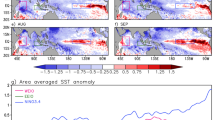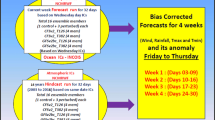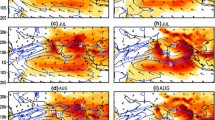Abstract
The diagnosis of the summer monsoon features over India are investigated using global analysis and forecast system (GFS) of the National Center for Environmental Prediction (NCEP). In addition, the performance of the NCEP GFS model in capturing the observed rainfall variability of the summer monsoon features over India through diagnostic parameters. We delineate the variability between two normal monsoon seasons with basic meteorological fields and significant parameters of kinetic energy, heat and moisture budgets. The 1200 UTC operational analyses and forecasts (day1 through day5) data for summer monsoon seasons of June, July, August and September (JJAS) of 2010 and 2011 are considered. Although both are normal monsoon seasons with seasonal rainfall (JJAS) departure of about −3.1% and 2.1% respectively, during 2010 and 2011, some differences are observed in the spatial distribution of rainfall. The diagnostic fields reasonably reproduced the variations in analyses and forecast fields of up to 5 days. The model forecasts of day1 delineated that the Indian summer monsoon features are well captured, whereas in day3 and day5, forecast depicts some differences. Overall the NCEP analysis and forecast fields not only produces mean monsoonal flow, but also captures seasonal variability realistically. This is evident from the large-scale balances represented by the analyses and model forecasts.
Highlights
-
The NCEP global analyses and forecast System depicts less bias in low level circulation in day1 with respect to analysis field, albeit, this bias is increases with increase of forecast period. Overall, the mean monsoon circulation is captured by the NCEP analyzes and forecast system fairly well.
-
The forecast fields illustrate the warm bias in the low levels with maximum over northwest India and monsoon through region, These warm bias in the forecast fields is due to the higher specific humidity over the monsoon trough region.
-
In the forecast of day1, day3 and day5 show the warm bias in the low levels at 925 hPa with maximum over northwest India and monsoon trough region, whereas cold bias is observed over Gujarat and Western Ghat in day3 and day5 forecast.
-
The significant seasonal variability perceived in two normal summer monsoon rainfall. This variability is captured by analysis and model forecasts realistically in terms of diagnostic fields of kinetic energy, heat and moisture.










Similar content being viewed by others
References
Chu J H, Yanai M and Sui C H 1981 Effects of cumulus convection on the vorticity field in the tropics. Part-I: The large scale budget; J. Meteor. Soc. Japan 59(4) 535–546.
Kanamitsu M 1989 Description of the NMC global data assimilation and forecast system; Wea. Forecasting 4 335–342.
Krishnamurti T N, Bedi H S and Subramaniam M 1989 The summer monsoon of 1987; J. Climate 2(4) 321–340.
Krishnamurti T N, Bedi H S and Subramaniam M 1990 The summer monsoon of 1988; Meteorol. Atmos. Phys. 42 19–37.
Kung E C and Tanaka H 1983 Energetics analysis of the global circulation during the special observation periods of FGGE; J. Atmos. Sci. 40 2575–2592.
Mohanty U C and Ramesh K J 1995 Systematic errors in the medium range prediction of the Asian summer monsoon circulation; Proc. Indian Acad. Sci. (Earth Planet. Sci.) 104 49–77.
Mohanty U C, Raju P V S and Bhatla R 2005 A study on climatological features of the Asian summer monsoon: Dynamics, energetics and variability; Pure Appl. Geophys. 162(8–9) 1511–1541.
O’Brien J 1970 Alternative solutions to classical vertical velocity problem; J. Appl. Meteor. 9 197–203.
Parrish D F and Derber J C 1992 The National Meteorological Center’s spectral statistical interpolation analysis system; Mon. Weather Rev. 120 1747–1763.
Parrish D F, Derber J C, Purser R J, Wu W S and Pu Z X 1997 The NCEP Global Analysis System: Recent improvements and future plans; J. Meteor. Soc. Japan 75 359–365.
Ramesh K J, Mohanty U C and Rao P L S 1996 A study on the distinct features of the Asian summer monsoon during the years of extreme monsoon activity over India; Meteor. Atmos. Phys. 59(3–4) 173–183.
Raju P V S, Mohanty U C, Rao P L S and Bhatla R 2002 The contrasting features of Asian summer monsoon during surplus and deficient rainfall over India; Int. J. Climatol. 22(15) 1897–1914.
Raju P V S, Mohanty U C and Bhatla R 2005 Onset characteristics of the southwest monsoon over India; Int. J. Climatol, 25(2) 167–182.
Raju P V S and Bhatla R 2014 Evolution of withdrawal features of the southwest monsoon over India; Int. J. Climatol. 34 1860–1872.
Raju P V S, Mohanty U C and Hsu H H 2010 A study on drought features of the Indian summer monsoon 2002; Meteor. Atmos. Phys. 108(1–2) 43–55.
Rao P L S, Mohanty U C, Raju P V S and Iyengar G 2003 The Indian summer monsoon revealed by NCMRWF system; J. Earth Syst. Sci. 112(1) 95–112.
Sardeshmukh P D and Held I M 1984 The vorticity balance in the tropical upper atmosphere of a general circulation model; J. Atmos. Sci. 41 768–778.
Shukla J 1987 Interannual variability of monsoons; In: Monsoons, John Wiley & Sons, pp. 399–463.
Wang X and Lei T 2014 GSI-based four-dimensional ensemble-variational (4DEnVar) data assimilation: Formulation and single-resolution experiments with real data for NCEP global forecast system; Mon. Weather Rev. 142 3303–3324.
Webster P J, Moore A, Loschnigg J and Leban M 1999 Coupled ocean-atmosphere dynamics in the Indian Ocean during 1997–98; Nature 401 356–360.
Webster P J and Yang 1992 Monsoon and ENSO: Selectively interactive systems; Quart. J. Roy. Meteorol. Soc. 118(507) 877–926.
Acknowledgements
The authors are grateful to the NCEP for providing the analysis and forecast data and IMD for providing gridded rainfall data to carry out the present study. We also sincerely thank to the two anonymous reviewers for their valuable suggestions/comments which further improved the manuscript. This work is supported by Department of Science and Technology (DST) Climate Change Programme (DST/CCP/NCM/71/2017 (C)), Govt. of India.
Author information
Authors and Affiliations
Contributions
P V S Raju: Conceptualization of the study, data processing and computations, manuscript preparation with support of co-authors. Akhilesh Mishra: Interpretation of the results and preparing first draft of the manuscript. A B T Sundari: Data processing and preparation of the figures.
Corresponding author
Additional information
Communicated by Kavirajan Rajendran
Rights and permissions
About this article
Cite this article
Raju, P.V.S., Mishra, A. & Sundari, A.B.T. Indian summer monsoon features in the NCEP analysis and forecast system. J Earth Syst Sci 129, 217 (2020). https://doi.org/10.1007/s12040-020-01487-w
Received:
Revised:
Accepted:
Published:
DOI: https://doi.org/10.1007/s12040-020-01487-w




